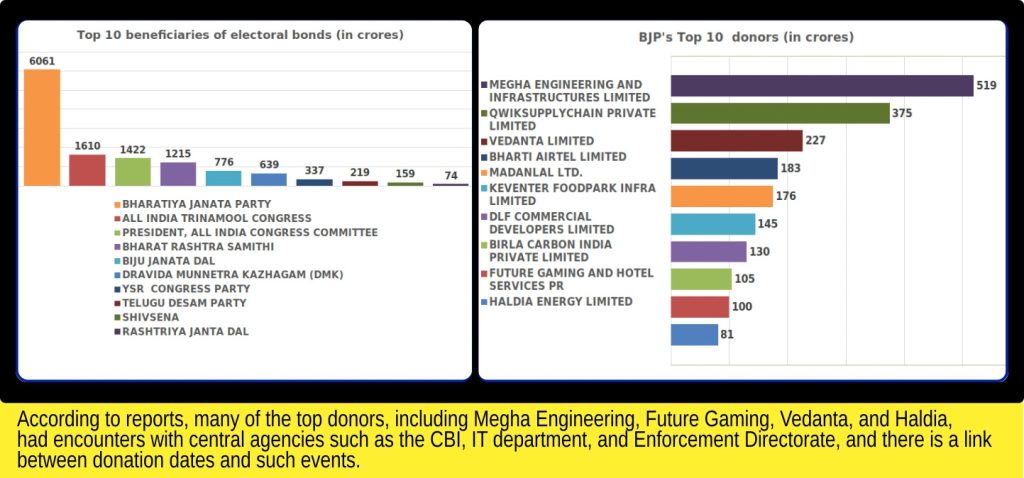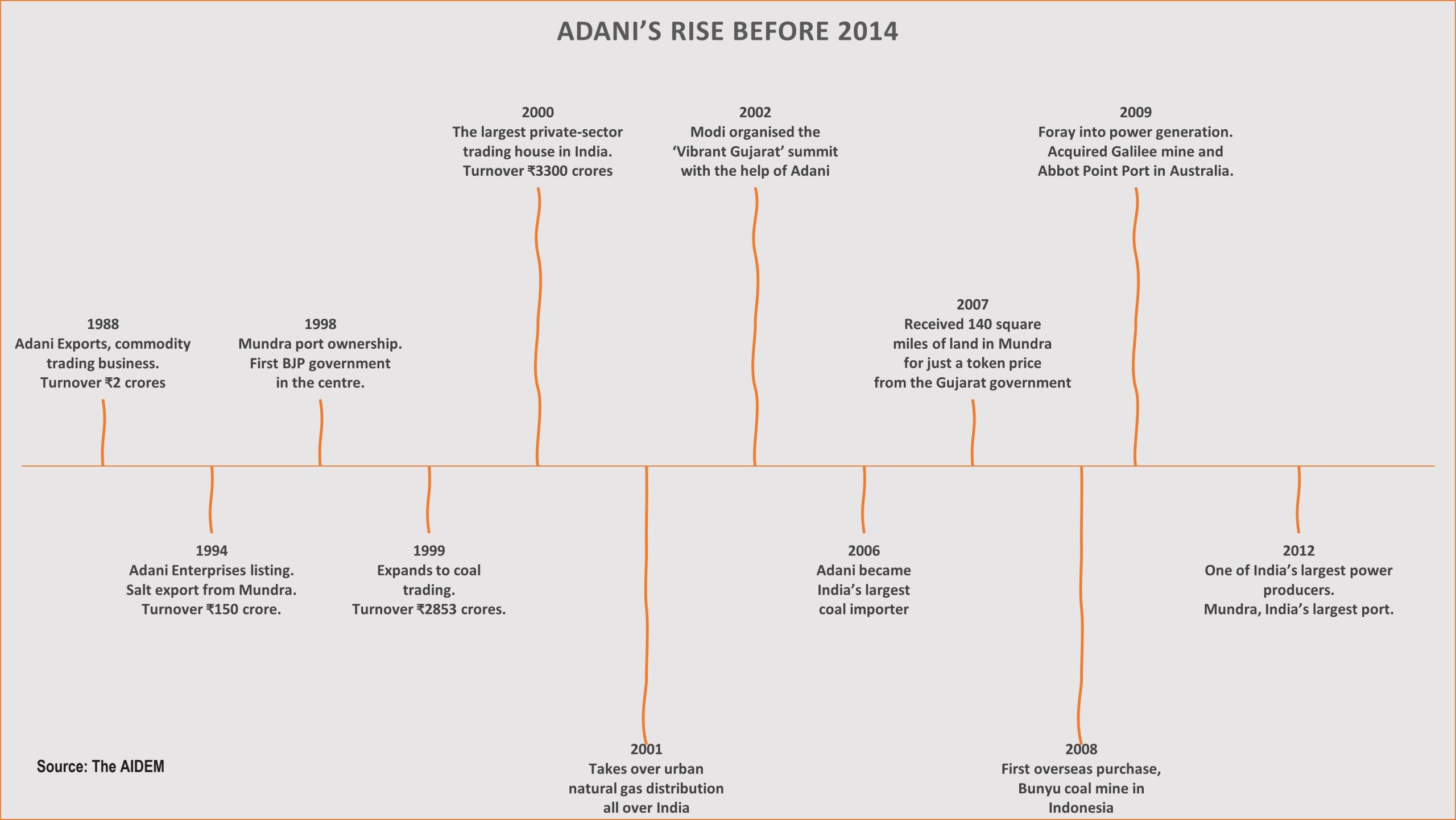

K. Sahadevan
“‘ना खाऊंगा ना खाने दूंगा’ ” (Neither eat nor feed.) This was one of the promises made by Narendra Modi, the BJP’s prime ministerial candidate, to the country’s people during the 2014 general elections. Corruption was the main issue in the election campaigns at the time. Those were the days when the BJP and its allies went on a rampage against major corruption scandals perpetrated by the Congress regime, such as the Commonwealth Games, the coal scam, and the 2G spectrum. On the other hand, ‘India Against Corruption’, led by Anna Hazare, was actively campaigning against corruption. In that context, Modi stated that if the BJP comes to power under his leadership, he will not commit corruption or allow others to do so.
“The long-term consequences of the Modi-era scandals will affect not only the incoming government but also future generations. It must be remembered that they can not be prevented without policy corrections.”
It has been a decade since Narendra Modi became Prime Minister. It would be useful to examine how free of corruption the Indian political arena was during these ten years. Before we get into that, let us go over the various types of corruption.
Although both are commonly referred to as corruption, transactional and systemic corruption are very different in nature and practice. Transactional corruption refers to corruption that occurs in everyday life. This includes everything from obtaining a driver’s license to paying bribes in government offices to obtaining government contracts, and so on. Bribes paid by ordinary people to illegally relax contract terms and pretend they did not see a breach of contract or to avoid delays in legally required services are examples of such corruption. This is generally regarded as the true face of corruption.
The second category of corruption is systemic corruption. It is difficult to quantify the impact of this corruption, which takes place through policy decisions and legislation, on the country’s public wealth, exchequer, and future resource availability. This is an analysis of how, in the past ten years, systemic corruption—which usually stays out of the public eye or does not cross people’s minds—has been carried out more efficiently.
It is a fact that legislation or good governance alone cannot eradicate corruption in a nation where it is a cultural condition. We can therefore assume that Modi was merely stating that no minister would be permitted to engage in corruption while he was in office. We all know, however, that despite the shadow of corruption allegations surrounding BJP state chief ministers and Union ministers during the Modi administration, the prime minister did not attempt to carry out any sort of inquiry or to remove the implicated colleagues.
Former Rajasthan Chief Minister Vasundhara Raje Scindia has not been investigated for allegedly assisting Lalit Modi in the IPL league scam. Similarly, it is clear that Narendra Modi, who has declared himself anti-corruption, is unwilling to announce an investigation into India’s largest defence scandal, the Rafale aircraft case, in which the Prime Minister and Defence Minister are directly involved.
The Rafale scam
The Rafale scam can be explained briefly as follows: The Modi government reduced the previous government’s plan to buy 126 fighter jets for the country to 36. The Indian government was close to finalizing a deal to buy 126 Rafale fighter jets for Rs 563 crore each. However, the Modi government has struck a new deal to purchase 36 aircraft for Rs 1,660 crore each. The abrogated agreement was nearly 95% agreed upon. It should also be noted that the then-Defence Minister, Manohar Parrikar, the Cabinet Committee on Security Affairs, and the Air Force were not consulted before changing the terms of the Rafale deal. Eleven years after the first tender was issued, the same manufacturers were invited to submit the same tender again with almost identical products and the same design.
The Modi government violated all logical common practices in favor of inexperienced private firms, including Anil Ambani’s debt-ridden business firms. It removed the experienced public sector firm Hindustan Aeronautics from the contract, canceled the “request for proposals,” and awarded the manufacturing contract to France’s Dassault Aviation, disregarding the competitive bids of the other manufacturers. With the Rafale deal, Modi and his colleagues not only caused losses to the public exchequer through wrongful dealings, but they also destroyed the transparency that should be maintained when spending public funds.
The opposition has demanded the formation of a Joint Parliamentary Committee (JPC) to investigate the Rafale deal, as it did in the Bofors case. However, the Modi government refused to accept such a demand. The French authorities have also claimed that the Modi administration is obstructing the release of official documents that would aid the investigation into the Rafale scam in France.
Adani, Modi’s Rockefeller
It is well known that the rise of Gautam Adani and his business empire, Adani Enterprises, is linked to Prime Minister Narendra Modi’s reign. Gautam Adani’s economic growth from the day Modi took office as Gujarat’s Chief Minister in 2001 until the end of his ten-year tenure as Prime Minister serves as clear evidence of this. From an annual turnover of just Rs 3,741 crore in 2002, Adani Enterprises has grown into an industrial firm with a turnover of Rs 75,659 crore by 2014. We have also seen that Adani got into the port industry when it bought Gujarat’s Mundra Port, growing into a massive conglomerate that now owns the majority of the country’s ports, airports, coal mines, and power plants.
It should not be forgotten that in 2014, Narendra Modi used Gautam Adani’s private jet to travel to Delhi from Ahmedabad to take the oath of office as prime minister of India. Also, remember that during all of Modi’s subsequent foreign trips as Prime Minister, representatives from Gautam Adani’s business empire accompanied him.
Gautam Adani, Chairman of Adani Enterprises, saw his company’s total revenue increase to US$32 billion between 2014 and 2024, propelling him into the ranks of the world’s richest people. The Adani Group now operates in every business sector. Adani’s influence has grown over the last decade in all of the industries mentioned above, as well as others such as food processing, infrastructure, defence, data collection, health, and entertainment. In Gautam Adani’s success story, we have seen the rise of business oligarchy in ways that the Indian industrial sector has never seen before.

It has often been stated that it cannot be judged solely on the success of an entrepreneur’s business strategies. As Prime Minister, Narendra Modi has been trying to set up the entire country’s institutions to facilitate Adani’s foray into whatever sector it wants. The Prime Minister did not hesitate to use all of India’s independent investigative and regulatory agencies, including the Enforcement Directorate, the Directorate of Revenue Intelligence, the Stock Exchange Board of India (SEBI), and the CBI, to advance Adani’s interests.
Paranjoy Guha Thakurta, a renowned journalist who has extensively investigated the Adani-Modi relationship, has uncovered a wealth of evidence. His detailed reports on Gautam Adani’s rise to prominence as India’s largest airport operator describe how the ED raided the Hyderabad-based GVK Group and forced it to withdraw from the tender process to take over the Mumbai airport. In a similar vein, reports have surfaced of companies, including NDTV, being raided and their shares purchased by Adani.
It has been one year since the release of the Hindenburg report on the manipulations made by industrial firms under Gautam Adani in the equity market. During this time, there was much debate about the misguided freebies provided by the Narendra Modi government to the Adani business empire. While Gautam Adani’s stock market manipulations are having far-reaching consequences on a global scale, in India, regulatory and investigative agencies such as SEBI and ED remain completely silent, with the ruling parties deliberately interfering to avoid discussing the issue in Parliament. This demonstrates that the administration is afraid of the legitimate request of a Joint Parliamentary Committee or a Judicial Committee to investigate a massive financial scam, the likes of which are unprecedented in the country. It is also worth noting that the Indian Prime Minister has not spoken one word about the Hindenburg Report.
It should also be noted that Modi attempted to obstruct the investigations by including Gautam Adani’s family members on Sebi’s Corporate Governance Committee, which was tasked with investigating the irregularities in the stock transactions. It is also worth noting that one of the 24 members of the SEBI committee investigating the Adani share irregularities is Karan Adani’s father-in-law, the son of Cyril Shroff Adani, chairman of the firm Cyrilchand Amarchand Mangaldas, which handles Adani’s legal affairs.
It was later revealed that foreign policies and relations were being changed in favour of Adani’s business interests, forcing countries such as Sri Lanka and Bangladesh to sign agreements with Adani. It came to light that Modi had forced Prime Minister Rajapaksa to award the contract related to power projects in Sri Lanka to Adani.
The passing of an ordinance to transfer coal mines in India to private companies, as well as the awarding of 12 of the privatized mines to Adani while the country was gripped by the COVID pandemic, did not make headlines. By creating an artificial coal shortage, coal plants in India were shut down. Coal plants in India were shut down, creating an artificial coal shortage. It was only recently that newspapers such as the Financial Times revealed evidence that Adani forced the Ministry of Energy to purchase imported coal and formed various shell companies that sold coal to the government at exorbitant prices.
Institutionalized corruption
If there is one thing that Narendra Modi has done very effectively, it is that he has institutionalized and legalized corruption. The most recent electoral bond scam is the best proof of this. The Electoral Bond first appeared in the Election Donation Act, which was passed by the Modi government in 2017 with the stated goal of making election donations transparent and eliminating black money transactions. It was designed to create special bonds for political party donations, which could be purchased by any Indian citizen through the State Bank of India and donated to their preferred parties. The plan, which appears to be very innovative at first glance, has been accused of being extremely secretive and serving the state’s vested interests. Institutions, including the Reserve Bank, were informing the government of their concerns about the implementation of the Electoral Bond Scheme. Despite all these objections, Finance Minister Arun Jaitley announced the Electoral Bond Scheme in February 2017 during his budget presentation.
The figures of donations received in the first phase revealed who were the true beneficiaries of the Electoral Bond Scheme, which was implemented in January 2018. 93% of electoral bonds sold in 2018–19 went to the ruling BJP’s account as donations. The government decided to keep information about bond buyers secret in the Electoral Bond Scheme, which was implemented under the guise of promoting transparency in donations. Later, when the case involving the Electoral Bond Scheme reached the Supreme Court too, government lawyers representing the central government claimed that the public did not need to know about the donors. The Electoral Bond Scam, which was finally exposed by the Supreme Court’s strict intervention, reveals that companies and individuals involved in various types of financial fraud donated to political parties via bonds. The ruling BJP has amassed thousands of crores of rupees by raiding and threatening companies engaged in various financial irregularities.
The fact that these include vaccine manufacturing companies, illegal lottery vendors, land dealers, and construction firms cannot be dismissed as a simple case of corruption. People’s health and resource security are jeopardized by assisting such companies and accepting donations in exchange. This is just one example of systemic corruption perpetrated through legal means and the majority in Parliament. Another issue is that even opposition political parties are unwilling to investigate the legal structures that allow for the ongoing looting of public resources in the name of national progress and development or to expose the systematic corruption that lies behind them.
If you look at the list of legislative acts and amendments passed during the Modi era, you can see how serious their attempts to legalize systemic corruption were. Because it would be difficult to examine all of the rules in detail, some of the most important are provided as examples.
Undoubtedly, the three agricultural laws repealed by the central government following the epic agitation of Indian farmers were attempts to institutionalize corruption. It should be noted that even before the Agriculture Laws Bill was introduced in Parliament, Gautam Adani had announced major investments in the agriculture sector, particularly in the food procurement sector. It was clear as day that by amending the Essential Commodities Act and ending the government’s monopoly in the food procurement sector, the government was creating opportunities for large corporations to enter, particularly Gautam Adani and his company, Adani Agri Logistics Ltd.
It should also be noted that Gautam Adani began the construction of modern foodgrain storage facilities in states such as Haryana and Uttar Pradesh long before the legislative process began in Parliament. Farmers were the first to recognize the systematic corruption on behalf of large corporations, which jeopardized the country’s food security. That is why they became the leaders of the protests against both the central government and the Adani-Ambanis.
Another example of systemic corruption is a bill introduced in Parliament in August 2021 to amend the Coal Bearing Areas (Acquisition and Development) Act of 1957 to keep the country’s mineral-bearing areas, including coal, in public ownership and to acquire land as needed. With this amendment, the Modi government has eliminated public ownership in the coal sector, breaking Coal India Limited’s monopoly. Before that, the government had passed Ordinances (2020), allowing private companies such as Adani to mine coal blocks.
The Labor Act, Land Acquisition Act, Right to Information Act and numerous other laws were amended during the Modi administration, permanently creating ‘legal’ avenues for large corporations to exploit resources and labor.
The long-term consequences of the Modi-era scandals will affect not only the incoming government but also future generations. It must be remembered that they can not be prevented without policy corrections.
K. Sahadevan is a social activist and author. He has written extensively on environmental issues, climate change, development, political economy, the agrarian crisis, and communalism.
























